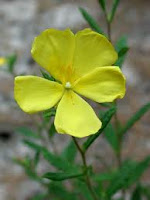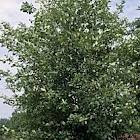Frostwort is native to North America , and was regarded as a curiosity by early botanists. In the early morning, moisture from the soil is driven upwards through the roots and this causes cracks just where the base of the stem rises above the ground. The stem bursts and this moisture becomes particles of ice in the cold temperatures in winter. This is why it is called the Frostwort or Frostweed.
Frostwort has other synonyms for its genus, these being, Cistus canadensis, Linné and Croeanthemum canadense. Helios is the Greek word for sun, and anthemum means flower so its genus names mean sunflower from Canada .
Professor Amos Eaton (1776-1842) noted the phenomenon but did not know how it was caused. This is what he observed:
“In November and December of 1816 I saw hundreds of these plants sending out broad, thin, curved ice crystals, about an inch in breadth, from near the roots. They were melted away by day, and renewed every morning for more than 25 days in succession.”
Like figwort in Europe this plant was used to treat scrofula, although it is not in the Scrophulaceae family, but the Cistaceae one. The whole plant was used in traditional medicine, being bitter and astringent due to the presence of tannins. The stem and leaves of the plant are covered in soft white hairs, and it is a branching plant with the branches growing longer than the main stem. It produces yellow flowers between the months of May and July. It grows to between 8 inches and 2 feet.
The plant is used in infusions and stronger decoctions to treat a number of illnesses. An infusion of it is used for diarrhoea and dysentery and an infusion of the leaves is used for kidney problems and a gargle for sore throats. This is the tisane. The stronger decoction of the leaves was used for scrofula and was also used as an eyewash for infections and for skin problems externally. A poultice of the leaves was also applied in cases of skin problems. It was thought to be very efficacious as a wash for scrofulous sores and ulcers on the skin.



















































